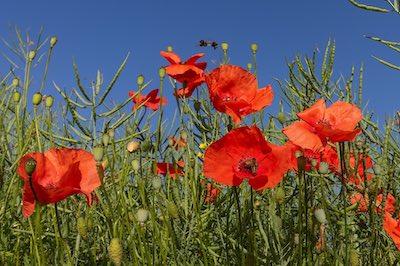History: From 1914 to 1918, World War I took a greater human toll than any previous conflict, with some 8.5 million soldiers dead of battlefield injuries or disease. The Great War, as it was then known, also ravaged the landscape of Western Europe, where most of the fiercest fighting took place. From the devastated landscape of the battlefields, the red poppy would grow and, thanks to a famous poem, become a powerful symbol of remembrance.
Across northern France and Flanders (northern Belgium), the brutal clashes between Allied and Central Powers soldiers tore up fields and forests, tearing up trees and plants and wreaking havoc on the soil beneath. But in the warm early spring of 1915, bright red flowers began peeking through the battle-scarred land: Papaver rhoeas, known variously as the Flanders poppy, corn poppy, red poppy and corn rose. As Chris McNab, author of “The Book of the Poppy,” wrote in an excerpt published in the Independent, the brilliantly colored flower is actually classified as a weed, which makes sense given its tenacious nature.

Lieutenant Colonel John McCrae, a Canadian who served as a brigade surgeon for an Allied artillery unit, spotted a cluster of poppies that spring, shortly after the Second Battle of Ypres. McCrae tended to the wounded and got a firsthand look at the carnage of that clash, in which the Germans unleashed lethal chlorine gas for the first time in the war. Some 87,000 Allied soldiers were killed, wounded or went missing in the battle (as well as 37,000 on the German side); a friend of McCrae’s, Lieutenant Alexis Helmer, was among the dead.
MORE HERE

It is read EVERY year at our Memorial Day ceremony…a short but quite intense poem.
A fitting tribute to the millions who died in The Great War and all other wars.
Thank you all for your service and sacrifice
A fitting tribute to a banker’s war and the fools who fought in it.
Billy, Billy, Billy … that’s the old “dialectic materialist” chant.
Bankers can’t start wars – they can only finance the war once started.
Politicians start wars.
Industrialists (and exhaustion) end them.
izlamo delenda est …